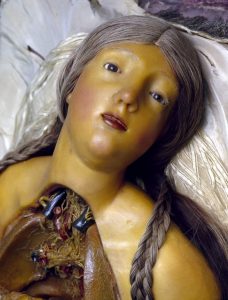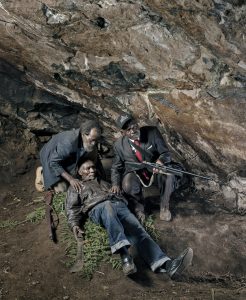More about that Playmobiel exhibition that just opened in Amsterdam. I was particularly intrigued by the software for mobile phones that can scan drawings and transform them into beats, so i asked Ubi de Feo, one of its developers to give me more details about it. He also uploaded images from the show on flickr.
It’s called RadarFunk and was conceived by Pips:Lab (initial concept) and TwoDotOne (mobile transposition and additional concepting).
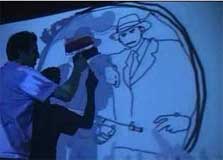
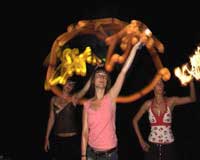 TwoThingsDotOne and Pips:Lab’ 3D graffiti
TwoThingsDotOne and Pips:Lab’ 3D graffiti
You might have heard of the guys. TwoDotOne was involved in the design of Nokia’s new flagship store in Moscow and collaborated to TwoThingsDotOne, a kind of magic coloring books application but for grown-ups to play on walls. Pips:Lab does some very nice 3D light graffiti. For example, their luma2solator installation invites the audience to create their own lumasol lightgraffities (photographs recorded with a long shutterspeed). The visitor has 30 seconds to make a drawing with spraycans that produce light. The build-in flash makes it possible to not only see the lightgraffity but also the creating artist. A soundtrack offers the visitor instructions of how the machine is operated (video.)
How does RadarFunk work?
Users are invited to frame one of the several patterns, shoot a picture, and the player starts sending notes to the server.
Framing exactly the center of the image can produce a regular beat, but moving a bit off center can give a shuffle result (swing).
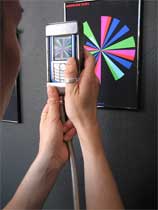
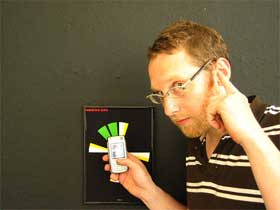
RadarFunk
What’s the technology behind the installation?
Several dj’s have created some beats, then the beats have been exported as text files. A Director application created by Pips:Lab’s founder Keez Duyves converts the text files to color patterns.
The mobile system uses a J2ME application developed by TwoDotOne, it is always connected to a computer via BlueTooth. The phone takes pictures and analizes the color patterns. Every color value triggers a note value based on a mapping. The notes are then sent to the server where 2 applications cooperate to create the sound. The speed (BPM) of the player can be increased or reduced and sound kits can be changed.
Now something about the BlueTooth server: BlueSocket is a technology developed by TwoDotOne. The concept and design are by Ubi de Feo and the programming is by Salvatore Iodice, a young and talented C++ programmer from Italy.
BlueSocket takes care of having several bluetooth clients attached to
it and routes their messages, exactly like a socket server does, but this time over a bluetooth network. This server allows for internet connections between mobiles over bluetooth as well as many other tasks, one of them is working as a remote controller. The other application can be multi-user games/experiences in spaces.
The interesting part of this project is that it will soon be free for artists and developers (beta testers wanted).
The music machine software is essentially a player that connects to the bluetooth server over a socket connection which can happen locally or over a network. The software hosts several sound kits that can be selected from the phone application.
How was the reaction of the gallery visitors?
SUPER POSITIVE. People loved the installation and some of them even danced to the generated beats. users started to take pictures of everything: clothes, shoes, passing trams.
UPDATE:
Keez from Pips:Lab gives some further insights:
“The ‘beats to rgb-pattern tool’ I made in the train from Delft to Amsterdam on Friday. That is not so much the app for me. It’s only a tool, cuz I’m lazy.
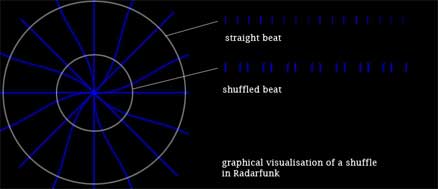
For me it’s important that beats can be distilled from any image, and our mobile version makes this even more possible. Only using the patterns we made would have kept the creativity away from the user, while the motto is: Fuck PIPS:lab you are the artist.
The basic idea is that an rgb has in fact three different channels and therefor can be used as a three channel “sequencer.” Furthermore, I once invented the tool as I was investigating the ‘shuffle’ or ‘odd timing’. Steven & Stije are both masters in timing off-beats. Some RadarFunk patterns can be seen as graphical representations of a shuffle. In the act of scanning them, one can alter the amount of shuffle, by changing the radius of the scanning circle.
Shooting an pattern off-center gives a weird feel to the beat, but this effect is quite different from a ‘shuffle’. In a shuffled beat only the ‘odd’ 16th notes get an offset.”
Check RadarFunk during the PLAYMOBIEL exhibition, at Arti, in Amsterdam, from June 10 till July 8.


